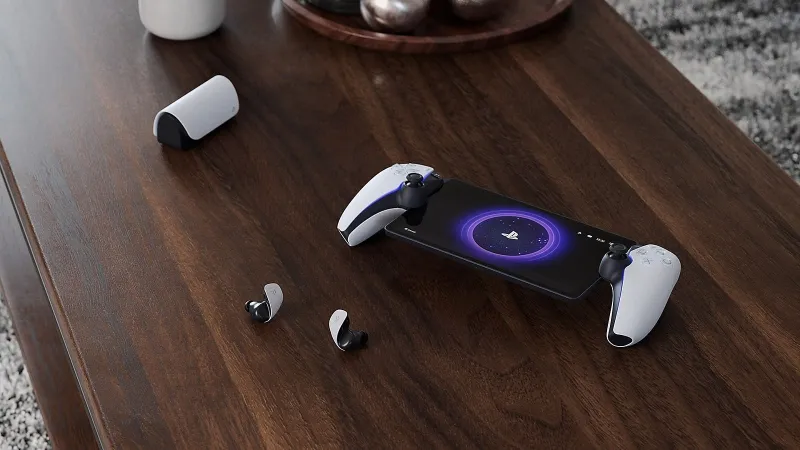


Today marks the release of the PlayStation Portal, Sony’s $200 remote player specifically built to accommodate players looking to enjoy their existing PS5 console and its library of games at home but while away from your main gaming display.
By any measure, the PlayStation Portal is a very targeted and specific-use product, and it’s worth clarifying out of the gate: This is not a standalone console in any way. Rather, the Portal allows you to connect to a PS5 you already have in your home over your Wi-Fi network (or any Wi-Fi network) and play the games you have downloaded on that PS5 from other places around your home. You can also connect the Portal to other Wi-Fi networks outside of your home, though our testing found inconsistent results when doing so. Regardless of where you connect from, remote play of this nature is not a new capability. For some time, you’ve been able to use existing devices like a smartphone to do the same, and if you have chosen to invest in a good connected controller interface (we’ve previously recommended the Backbone), you can already do much of what the Portal is offering.
So, who is this product for, exactly? And why might it be worth a buy?
The first part of that answer lies in the high quality of the hardware found within Sony’s new remote player, which may be a draw for many users. Many have noted the unusual appearance of the device, with its disconnected controller arms and squared-off screen. But in hand, it feels durable and comfortable. The textured grips feel good, and it has a satisfying but not overly heavy weight – think something just a bit heavier than a Nintendo Switch.
Unlike with connected controllers on a phone, the Portal retains the features that made the DualSense controller so celebrated at the PS5’s launch, including haptic feedback and adaptive triggers, and it’s great to feel those still present while playing.
The biggest selling point is undoubtedly the large 8-inch touch-display screen. The 1080p LCD display looks great in action, with sharp colors and deep blacks, though it’s worth noting that it looks best in dimmer spaces. Any way you cut it, the display is a step up in size from connecting your phone for remote play.
Running over home Wi-Fi, I found the Portal experience relatively seamless. Every user’s experience may vary depending on the strength of your network, but I found even when moving around to different rooms in the house, I didn’t run into significant lag, and the connection only dropped when I moved out of the range of my Wi-Fi.
The included speakers are perfectly adequate, but like many portable play options, your best bet is going to be to connect a decent set of headphones.

The second part of the answer about who this product is targeting is about how you engage with games in your home. For a small segment of players, it’s likely to have the high potential to get you playing more frequently and with greater ease.
If you share your primary gaming display with other members of the family who might be watching or playing something else, the Portal puts you exactly one power button-press away from getting back to your favorite PS5 game. And while I’m not going to be the person to recommend you play games in bed before going to sleep (it’s pretty bad for your rest), the Portal absolutely allows for that. I even enjoyed a session of Spider-Man 2 while sitting in my backyard – albeit while I remained within Wi-Fi range.
A lesser-discussed aspect of the Portal’s capabilities is around multiplayer engagement. I was able to continue a co-op session of TMNT: Shredder’s Revenge with a family member who was playing in the living room, while I monitored pots in the kitchen to make sure dinner wasn’t boiling over. The two of us were playing on different screens, but we were able to keep the game going while I needed to physically be in a separate space. By extension, you can also think about the Portal as one additional controller to add to your DualSense stable. It’s perfectly capable of acting in that capacity, even if you’re actually staring at the TV instead of the included screen. Of course, that use case is only a small added benefit – not a reason to pay $200 for a second controller.
The gaming world has been actively moving toward increased mobile options in recent years, and it’s likely that you may already be on that journey. Whether you play a lot of mobile games, check out Nintendo titles on your Switch, or you’ve made the jump to a portable PC like the Steam Deck or one of its competitors, there are now plenty of ways to experience quality gaming away from your TV or monitor.

The PlayStation Portal is less expensive than many of those options, but it has to be, since it’s presuming you’ve already spent the money on a PS5 as the actual system to play on. If you already have a robust library of PS5 games, but it’s sometimes been hard to sit down in front of the TV for a play session, the Portal should have a lot to offer. That appeal might be especially high for busy parents, people in a home with only one TV, or those who prefer playing on a smaller portable screen.
If that’s not you, I’d encourage holding off on a purchase of the Portal. It’s not built as some sort of revelatory new way to engage with PlayStation games. However, for someone who likes the idea of enjoying gameplay wherever you might be in the house, the Portal is the best way I’ve encountered to do that, providing an experience that is very close to what you’d get gaming directly on your PS5 console.

Explore your favorite games in premium print format, delivered to your door.